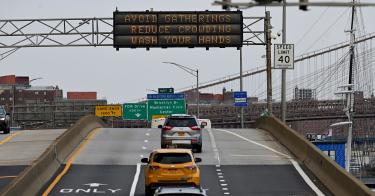Major events bring with them new words, phrases, and social responses. Some events—such as major terrorist attacks or global pandemics—call upon us to change how we deal with matters such as security or close personal interactions.
They challenge what we have known as normal and ask us to consider what new measures might be needed to deal with a profound change in our environment. Some changes are temporary; others become part of the “new normal.”
The beauty of reorienting to new challenges within a free society is that it ultimately rests with the people to accept or reject such changes.
Our history shows that people quickly recognize what is needed in times of crisis and do our part not only to protect ourselves and our loved ones, but to contribute to the broader needs of our community in ways that preserve our culture, governing structures, and the various rights and liberties that define our nation.
Social distancing, quarantine, shelter in place, panic buying, “You’re worth your weight in toilet paper,” … these are the 2020 equivalents of “Where’s the beef?” and “I’ve fallen and I can’t get up!”
Cancellation of sporting events, school commencement exercises, birthday parties, weddings, and public funerals reshape our calendars in unsettling ways. And to top the list of changes that seem to cascade with each passing day, governments from local to federal are calling upon us to change how we travel, how we exercise our right to assemble, and even whether we are free to roam about our communities.
How do we determine what is overreach and what is necessary? How do we think about our ability to retain control of our circumstances and balance the broader needs of our friends, neighbors, and larger communities?
History provides many lessons in how societies have dealt with existential threats, especially those posed by communicable disease, with lethal consequences.
The idea of separating the sick from the healthy to protect society dates back to the dawn of human history and continues to be an effective way to blunt the spread of disease.
The Book of Leviticus records divine instruction to the Israelites to separate lepers from everyone else—to have them live apart from the camp to prevent the spread of the disease.
Various accounts of war across the ages reveal that people understood disease could pass from person to person, even if they did not understand how that actually happened.
Plagues have afflicted humanity over the centuries and were used as weapons of war for centuries before the modern world got around to outlawing such use.
During the Peloponnesian War of the 5th Century, B.C., Athens, under siege by Sparta, suffered a plague so massive it devastated the city, weakening the Athenian military and damaging the cohesion of Athens itself, and hastened Sparta’s victory.
The impact of disease on the future of nations can be profound, hence the reaction of societies to protect against it.
To guard against the spread of pestilence, societies developed rules or protocols for containing illness. The sick were forbidden to enter the walls of a town; ships that arrived at a port with disease among the crew were required to wait at a safe distance in the harbor until authorities were satisfied the danger had passed.
During the mid-1300s, the bubonic plague, also known as the Black Death, swept across Europe, devastating populations (some 25 million people died in Europe, perhaps 100,000 in London alone). Originating in Asia, it is thought to have been carried to Europe by trading ships, commonly infested with rats that carried fleas infected with the plague virus.
The port city of Ragusa, along the Adriatic coast of what is now Croatia, instituted an isolation period of 30 days (a trentino) for any person thought to be sick, especially visitors to the city, whether arriving overland or by ship.
Other cities saw wisdom in this and started implementing similar measures. In Venice, the period of isolation that a ship would have to lie at anchor was extended to 40 days—a quaranta (Italian), from which we get the English word quarantine.
The concepts of isolating (separating someone known to have a contagious disease from the rest) and quarantining (separating and restricting the movement of people who were exposed to a contagious disease to see if they become sick) are meant to protect a larger population from infection by slowing the spread of disease and buying time to determine who is truly sick so medical resources can be properly directed.
Both measures are at the extreme end of a spectrum of steps people and societies take to reduce transmission of disease. At the other end of the spectrum is simply keeping one’s distance from other people—“social distancing.”
Social distancing, limiting travel, canceling trips abroad (airplanes, cruise ships, buses, and trains put people into close contact settings by design), restricting large public gatherings, calling for voluntary sheltering at home, imposing a quarantine, and imposing a mandatory lockdown that forbids all movement, as was implemented in Wuhan, China, illustrate the various measures available to individuals, societies, and governments.
In the U.S., the legal authority to implement such restrictions comes from various statutes that authorize the Centers for Disease Control and Prevention to manage the flow of people into and around the United States when it becomes important to stem the transmission of disease.
Its Division of Global Migration and Quarantine uses regulationsapplicable to controlling communicable diseases. In fact, “isolation and quarantine also are “police power” functions, derived from the right of the state to take action affecting individuals for the benefit of society.”
This power, which the government is given by the Commerce Clause of the U.S. Constitution, has not been used nationwide since the Spanish influenza pandemic of 1918-1919, although the federal government has stepped in to manage public health crises on numerous occasions.
Today, the Division of Global Migration and Quarantine operates 20 quarantine stations at primary points of entry into the country. The Centers for Disease Control and Prevention advises the executive branch, implements applicable isolation and quarantine policy directives, and helps to inform the legislative branch on large-scale matters such as epidemics and pandemics.
The current debate among governments at every level is how best to protect the health of the population and preserve the individual liberty and privacy rights and the economic activity on which all Americans depend.
Restrictions on travel, eating in restaurants, and enjoying sports and cultural events are taking a massive economic toll, but they are meant to preserve life and mitigate severe illness.
Several European countries have implemented extreme measures to halt the pace of infection and many U.S. states are following suit, including New York, California, Illinois, and New Jersey. Quarantines are an effective tool to limit normal interactions.
The greatest challenge posed by COVID-19 is that a person can be infected, exhibit no symptoms, and yet be contagious to others for up to two weeks. Over that time, the unknowingly afflicted could interact with hundreds of other people and leave the virus on common surfaces, potentially infecting many more. This is why governments and communities have restricted movement.
Quarantining, a more extreme form of voluntary distancing and minimizing travel, has proven to be a simple, very effective technique for stemming the spread of highly communicable disease for centuries. It should come as no surprise that the technique remains effective today in the modern world.
Sometimes old ways remain effective for a reason and an age-old measure that draws its name from actions adopted 600 years ago should actually provide reassurance that things can be done when everything else in our world seems surreal and unsettled.
Regardless the options selected by governments, it is up to us to do our parts to minimize the risk to ourselves, our families, and our community.
Now go wash your hands!
This piece originally appeared in The Daily Signal




